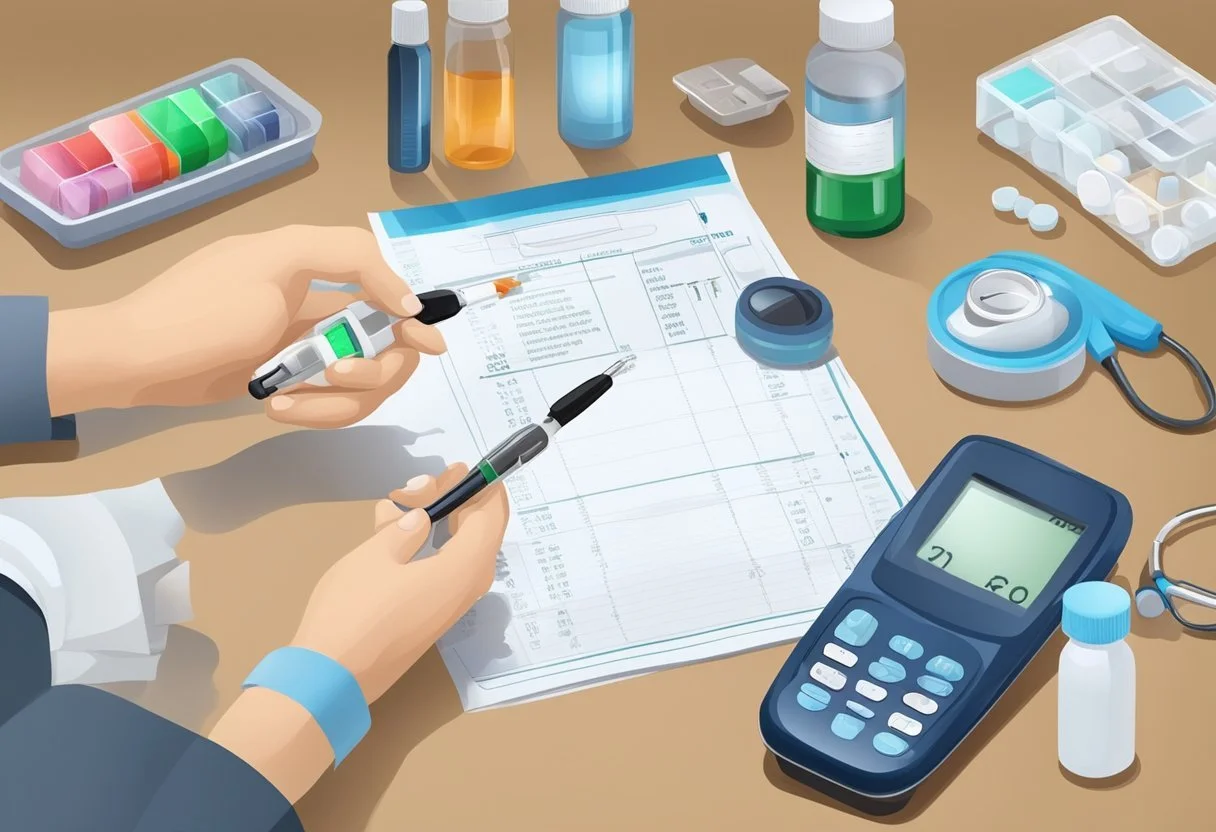Diabetes
Symptoms, Causes, and Home Remedies
Discover > Health Conditions > Diabetes: Symptoms, Causes, Home Remedies
Diabetes is a chronic health condition that affects millions of people worldwide, posing significant risks to their overall well-being. It occurs when the body either doesn't produce enough insulin or cannot effectively use the insulin it does produce. Insulin, a hormone produced by the pancreas, is crucial for regulating blood sugar (how long does sugar last?) levels. Thus, understanding the symptoms, causes, and possible home remedies becomes essential for individuals diagnosed with this ailment, as well as their families and caregivers.
There are two primary types of diabetes: Type 1, an autoimmune disease affecting insulin production, and Type 2, which results from insulin resistance. Common symptoms include frequent urination, constant thirst, unexplained weight loss or gain, fatigue, and blurred vision, among others. Although some causes are genetic, lifestyle factors, such as poor diet, sedentary behavior, and obesity, play a significant role in the development of this condition.
Natural and home remedies complement prescribed treatments, empowering individuals to manage their blood sugar levels more efficiently. Among these remedies are dietary changes, physical activity, stress management techniques, and other alternative therapies. This article aims to provide valuable information and insights on the symptoms, causes, and home remedies for diabetes, empowering those affected to take control of their health journey.
Understanding Diabetes
Diabetes is a chronic health condition in which the body is unable to effectively regulate blood sugar levels. This is primarily due to either the insufficient production or inefficiency in the use of insulin, a hormone produced by the pancreas that facilitates the uptake of glucose from the bloodstream into the body’s cells to be used for energy. There are several types of diabetes, the most common being Type 1 diabetes, Type 2 diabetes, and latent autoimmune diabetes in adults (LADA).
Type 1 diabetes is an autoimmune disease where the immune system attacks and destroys insulin-producing cells in the pancreas. This results in little or no insulin being produced, leading to high blood sugar levels. Though its exact cause is unknown, genetics is believed to play a role.
On the other hand, Type 2 diabetes is characterized by insulin resistance – a condition wherein the body’s cells do not respond properly to insulin, leading to high blood sugar. Both genetic and lifestyle factors, such as obesity and physical inactivity, contribute to the development of Type 2 diabetes.
Latent autoimmune diabetes in adults (LADA) is a less common form of diabetes that shares features of both Type 1 and Type 2 diabetes. It is an autoimmune disease with a slower progression than Type 1 diabetes, often mistaken for Type 2 diabetes due to its later onset in life.
Another type of diabetes is diabetes insipidus which is caused by the insufficient production of the hormone vasopressin. However, this type of diabetes is unrelated to insulin or blood sugar regulation and is characterized by excessive water loss through urination.
High blood pressure, also known as hypertension, is a common complication in people with diabetes. The relationship between blood pressure and blood sugar is complex, with each contributing to the development and progression of the other.
Some common symptoms of diabetes include:
Frequent urination
Increased thirst
Unexplained weight loss
Fatigue
Blurry vision
Slow-healing wounds
Early detection and management of diabetes are essential in minimizing its long-term complications. Adopting healthy lifestyle choices, such as a balanced diet and regular physical activity, can help in managing blood sugar levels and preventing complications. In some cases, medications or insulin therapy may also be necessary to achieve proper blood sugar control.
Regarding home remedies, it is crucial to discuss with a healthcare professional before implementing any changes to one's treatment plan – some remedies might interact with medications or worsen the condition. Nevertheless, managing stress, getting adequate sleep, and staying hydrated are important aspects in maintaining overall well-being for individuals with diabetes.
In summary, diabetes is a complex health condition with various types and causes. It is crucial for individuals to understand their specific type of diabetes and work with healthcare professionals to develop appropriate management plans. Combining healthy lifestyle practices, medical interventions, and continuous monitoring can aid in keeping diabetes under control and minimizing long-term health risks.
Main Symptoms of Diabetes
Physical Symptoms
Diabetes is a chronic condition that affects the body's ability to produce or utilize insulin effectively. It has several noticeable physical symptoms. Some common symptoms include increased thirst, leading to frequent urination, as the body tries to flush out excess sugar in the blood. People with diabetes may also experience dry, itchy skin due to dehydration caused by frequent urination.
Another physical symptom is sores and slow-healing wounds, particularly on the feet. These can be caused by nerve damage, poor circulation, or a weakened immune system, all potential consequences of diabetes. Additionally, people with diabetes may notice blurry vision which, if not addressed, can lead to more severe complications such as diabetic retinopathy or even blindness.
Significant Changes in Body Functions
Diabetes can also cause significant changes in various bodily functions. Some common changes include unexplained weight loss. This occurs because the body cannot efficiently convert glucose into energy and starts breaking down stored fat and muscle instead. As a result, people with diabetes might feel fatigue, weakness, and constant tiredness.
Increased hunger is another common change in body functions, as the body is unable to properly use the energy from the food consumed. With diabetes, individuals often experience fluctuations in blood sugar levels, which can lead to mood changes.
Lastly, long-term complications of diabetes can include nerve damage, kidney disease, heart disease, stroke, eye damage, and foot damage. It is crucial for those who have diabetes to manage their condition properly to minimize the risk of these complications.
To sum up, the main symptoms of diabetes can be categorized into physical symptoms like increased thirst, frequent urination, dry skin, slow-healing sores, and blurry vision; and significant changes in body functions such as weight loss, fatigue, increased hunger, mood changes, and the risk of complications like nerve damage and heart disease.
Common Causes and Risk Factors
Diabetes is a chronic health condition that affects how the body processes blood sugar (glucose). There are several factors, both genetic and environmental, that contribute to the development of diabetes. In this section, we will delve into the common causes and risk factors associated with this condition.
Type 1 Diabetes is primarily caused by the immune system mistakenly attacking the insulin-producing pancreatic beta cells. However, it has been observed that certain factors contribute to an increased risk, such as:
Family History: Having a parent or sibling with type 1 diabetes increases the likelihood of developing the condition.
Race: Type 1 diabetes is more prevalent in Caucasians than in African Americans, Asian Americans, or Hispanics/Latinos.
Environmental Factors: Exposure to certain viral infections, such as enteroviruses, may be linked to the development of type 1 diabetes.
Type 2 Diabetes and Gestational Diabetes share some common causes and risk factors as well:
Overweight and Obesity: Excess body weight, particularly fat stored around the waist, makes the body more resistant to insulin and increases the risk of diabetes.
Pregnancy: Hormonal changes during pregnancy can lead to insulin resistance, which may result in gestational diabetes.
Family History: Having a close family member with type 2 diabetes elevates the risk of developing it.
Race: African Americans, Asian Americans, Hispanics/Latinos, and Native Americans have a higher risk of developing type 2 diabetes.
Age: The risk of type 2 diabetes increases with age, particularly once an individual reaches 45 years or older.
In addition, lifestyle factors also play a significant role in the development of type 2 and gestational diabetes. These include:
Diet: Consuming a diet high in sugars, processed foods, and unhealthy fats can contribute to insulin resistance and elevated blood sugar levels.
Physical Inactivity: Leading a sedentary lifestyle can make the body less responsive to insulin, increasing the risk of diabetes.
Smoking: Smoking cigarettes has been associated with an increased risk of developing type 2 diabetes.
Acknowledging these causes and risk factors allows for the implementation of preventive measures, such as adopting a healthier lifestyle, which can help reduce the likelihood of developing diabetes.
Diagnosis and Testing for Diabetes
The process of diagnosing diabetes begins with a doctor's visit. Typically, a health care professional will ask about your medical history, conduct a physical examination, and order specific tests to determine whether you have diabetes or prediabetes.
One common test for diabetes is the blood sugar test or blood glucose test. This test measures the concentration of glucose in your blood. Two types of blood sugar tests are available: the fasting blood sugar (FBS) test and the oral glucose tolerance test (OGTT). The FBS test requires an 8-hour fast before the test, while the OGTT involves consuming a glucose-containing drink, then measuring blood sugar levels after a set time.
Another test used for diagnosing diabetes is the A1C test. This test measures your average blood sugar levels over the past 3 months. It provides a more long-term view of blood sugar control than the FBS or OGTT tests.
A1C test results are expressed as a percentage, with the following categories:
Normal: Below 5.7%
Prediabetes: 5.7% to 6.4%
Diabetes: 6.5% and above
If your doctor suspects that you may have type 1 diabetes or a more specific type called latent autoimmune diabetes in adults (LADA), they might also order tests to look for antibodies associated with these conditions. These tests can help distinguish between type 1, type 2, and LADA.
It's essential to diagnose diabetes as early as possible to allow for effective management of the condition, which will help prevent complications such as nerve damage, kidney disease, and heart disease.
In some cases, your doctor may recommend participating in a clinical trial. These trials test new medications, therapies, or devices for the diagnosis, treatment, and management of diabetes. By participating in a clinical trial, you may gain early access to cutting-edge treatments and contribute to the larger body of knowledge about diabetes research and care. However, it's essential to discuss the potential risks and benefits with your doctor before joining a clinical trial.
Home Remedies and Lifestyle Changes
Adopting a healthy lifestyle is crucial in managing diabetes. By making a few changes in daily habits, an individual can better regulate their blood sugar levels and minimize complications. The following are some home remedies and lifestyle modifications that can assist in controlling diabetes.
Diet: A balanced diet is essential in managing diabetes. Incorporate whole grains, fruits, and vegetables into meals as they are rich in fiber and help regulate blood sugar levels. Additionally, opt for lean protein sources like fish and chicken instead of red meat. The consumption of nuts (how long do nuts last?), as they're high in healthy fats, can also be beneficial.
Whole grains: These include brown rice, quinoa (how long does quinoa last?), barley (how long does barley last?), and whole wheat pasta. Whole grains are excellent sources of fiber and regulate blood sugar effectively.
Fruits and vegetables: Increase the intake of fresh fruits and non-starchy vegetables, which are essential sources of vitamins, minerals, and dietary fiber.
Nuts: Almonds (how long do almonds last?), walnuts (how long do walnuts last?), and pistachios are examples of nuts that can be consumed moderately to benefit from their healthy fats.
Exercise: Engaging in regular physical activity is crucial in managing diabetes. Aim for at least 150 minutes of moderate-intensity aerobic exercise per week, such as swimming, cycling, or brisk walking. Additionally, include resistance or strength training for muscle building, which may help enhance insulin sensitivity.
Lifestyle changes: Some simple daily adjustments can contribute to better diabetes management and overall health. The following tips can help:
Lose weight: Achieving a healthy weight through a combination of diet and exercise can significantly improve blood sugar levels and reduce the risk of diabetes-related complications.
Manage stress: Stress can negatively affect blood glucose levels, making it essential to practice stress-management techniques such as yoga, meditation, or deep breathing exercises.
Monitor blood sugar: Regularly self-monitor blood glucose levels to understand how certain foods or activities can impact them.
Have regular health check-ups: Schedule routine check-ups with healthcare professionals to monitor overall health and timely address any concerns.
While medication plays an essential role in diabetes management, incorporating these home remedies and lifestyle changes can result in a significant improvement in blood sugar regulation. It is important to remember that everyone's needs are unique, so consult a healthcare professional to create a personalized management plan.
Medical Treatments and Interventions
Current Medications
Several medications are available for managing diabetes. The type of medication depends on the individual's condition and the type of diabetes they have. The most common type of treatment involves the use of insulin. People with type 1 diabetes require regular insulin injections to maintain their blood sugar levels. There are different types of insulin, including rapid-acting, short-acting, intermediate-acting, and long-acting insulin. The choice depends on factors such as how quickly the insulin begins to take effect, peak time, and the duration of action.
For those with type 2 diabetes, various oral medications are available, which can be used in combination with dietary adjustments and exercise. Some commonly prescribed medications include:
Metformin: Reduces the amount of glucose produced by the liver, and increases insulin sensitivity.
Sulfonylureas: Stimulate the release of insulin from the pancreas.
DPP-4 inhibitors: Help lower blood sugar by regulating insulin levels after meals.
SGLT2 inhibitors: Prevent the kidneys from reabsorbing glucose, causing it to be eliminated via urine.
It is also essential for diabetics to keep their triglyceride levels in control to avoid complications. Medications such as fibrates and omega-3 fatty acid supplements can help manage elevated triglyceride levels.
Possible Medical Procedures
In some cases, more invasive interventions may be required to treat diabetes or its complications. These procedures can include a pancreas transplant and bariatric surgery.
A pancreas transplant is a surgical procedure where a donated pancreas is implanted into a person with type 1 diabetes. This new pancreas can produce insulin, helping the recipient maintain blood sugar levels. Pancreas transplants are typically considered for patients with severe cases, such as recurrent severe low blood sugars (hypoglycemic episodes) or advanced kidney disease resulting from diabetes. It is important to note that a pancreas transplant is a risky procedure with potential complications, such as infection and rejection of the donated organ.
Bariatric surgery, also known as weight-loss surgery, may be an option for individuals with type 2 diabetes who are obese. This surgical intervention can lead to significant weight loss and improvement in blood sugar control. Some common types of bariatric surgery include:
Gastric bypass: The stomach is divided into a small upper pouch and a larger lower pouch, and the small intestine is rerouted to the smaller pouch.
Sleeve gastrectomy: A large portion of the stomach is removed, and the remaining part is reshaped into a tube-like structure.
Both of these surgeries can lead to substantial improvements in blood sugar control. However, they also carry potential risks and complications. It is crucial to discuss the benefits and drawbacks of these medical procedures with a healthcare professional before deciding on a course of action.
Possible Complications of Diabetes
Diabetes, if not managed properly, can lead to a variety of complications. These complications are largely the result of chronically elevated blood sugar levels which can damage various organs and systems in the body. The following are some of the major complications that can arise from poorly managed diabetes:
1. Heart Disease and Stroke: Individuals with diabetes are at an increased risk of developing heart disease, as high blood sugar levels can lead to the deposition of fatty materials in blood vessels. This can cause narrowing or blockage of blood vessels, increasing the likelihood of experiencing a heart attack or stroke.
2. High Blood Pressure: Diabetes patients often suffer from high blood pressure. This is because the blood vessels become less elastic due to excess sugar in the blood. Consequently, this puts more strain on the heart and increases the risk of heart disease and stroke.
3. Kidney Disease: Over time, high blood sugar levels can harm the delicate filtering system in the kidneys; this can result in kidney disease, or diabetic nephropathy. In severe cases, kidney failure may occur, necessitating dialysis or a kidney transplant.
4. Eye Complications: Prolonged high blood sugar can damage the tiny blood vessels in the eyes, resulting in vision problems or blindness. The most common eye complication is diabetic retinopathy, where the blood vessels in the retina become damaged and may leak fluid.
5. Foot Damage: Diabetes can cause damage to the nerves and blood vessels in the feet, leading to various foot complications such as ulcers, infections, and deformities. In extreme cases, poor circulation and nerve damage can result in amputation.
To help prevent or manage these complications, it is crucial for individuals with diabetes to regularly monitor their blood sugar levels, follow a balanced diet, exercise regularly, and seek medical advice when necessary.
#diabetes mellitus #diabetes risk factors #diabetes complications #blood sugar level #losing weight #diagnose gestational diabetes #maturity onset diabetes #low blood sugar #health problems




